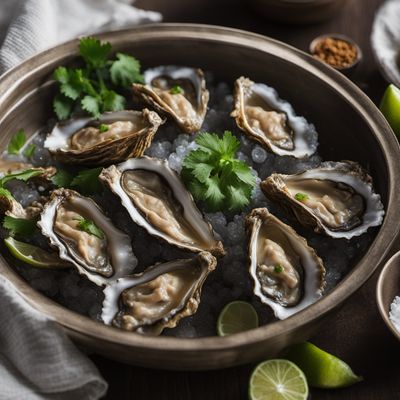
Ingredient
Oysters
"Oceanic Delicacy: Exploring the World of Oysters"
Oysters are bivalve mollusks with a hard, irregularly shaped shell that protects their soft, delicate flesh. They have a briny, oceanic taste with a hint of sweetness and a smooth, creamy texture. Oysters come in different sizes, ranging from small to large, and their appearance varies depending on the species and the region they are harvested from.
Origins and history
Oysters have a rich history dating back thousands of years. They were consumed by ancient civilizations such as the Greeks and Romans, who considered them a delicacy. Oysters were also highly valued in medieval Europe and were often served at royal banquets. Today, oysters are enjoyed worldwide, with different regions having their own unique oyster cultures and traditions.
Nutritional information
Oysters are a nutritional powerhouse, packed with essential nutrients such as protein, omega-3 fatty acids, zinc, iron, and vitamin B12. They are also relatively low in calories, making them a healthy choice for seafood lovers.
Allergens
Oysters are known to cause allergies in some individuals, particularly those with shellfish allergies. It is important to exercise caution and consult with a healthcare professional if you have any known allergies.
How to select
When selecting oysters, look for ones that are tightly closed or close when tapped. Avoid oysters with cracked or damaged shells. Freshness is key, so choose oysters that have a pleasant, briny smell of the sea. Additionally, it is recommended to purchase oysters from reputable sources to ensure their quality and safety.
Storage recommendations
To maintain the freshness of oysters, store them in the refrigerator at a temperature between 35°F and 45°F (1.7°C and 7.2°C). Keep them in a bowl or container with a damp cloth or paper towel to prevent them from drying out. It is best to consume oysters within a day or two of purchase for optimal flavor and quality.
How to produce
Oysters can be produced by cultivating them in oyster farms or through wild harvesting. Cultivating oysters involves placing oyster larvae or "spat" on suitable surfaces, such as oyster shells or artificial structures, and allowing them to grow in controlled environments.
Preparation tips
Before consuming oysters, it is crucial to shuck them properly. Use a sturdy oyster knife to carefully pry open the shell, being cautious of your hands. Once shucked, oysters can be enjoyed raw, steamed, grilled, or used in various dishes such as oyster stew, po' boys, or Rockefeller-style preparations. Pairing them with lemon juice, mignonette sauce, or hot sauce can enhance their flavor.
Culinary uses
Oysters are commonly enjoyed raw on the half-shell, but they can also be cooked in a variety of ways. They are often used in seafood stews, chowders, pasta dishes, and as a topping for pizzas or salads. Oysters can also be breaded and fried for a crispy appetizer or incorporated into stuffing for poultry or seafood dishes.
Availability
Oysters are commonly available in coastal regions around the world, including North America, Europe, Asia, and Australia. They are often cultivated in oyster farms or harvested from natural oyster beds.
More ingredients from this category
Recipes using Oysters » Browse all

Angelic Bacon-Wrapped Oysters
Heavenly Delight: Bacon-Wrapped Oysters with a Twist

Hong Kong-style Oyster Omelet
Savory Delight: Hong Kong Oyster Omelet

Charbroiled Oysters with Herb Butter
Sizzling Seaside Delight: Charbroiled Oysters with a Burst of Herb Butter

Chinese American Style Oysters Bienville
Savory Oyster Delight with a Chinese Twist

Spiced Oyster Roast with Indian Flavors
Tandoori Oyster Delight: A Fusion of South American and Indian Flavors

Burmese Chinese Style Oysters
Golden Crispy Oysters with a Burmese Chinese Twist

Peacemaker Po' Boy Sandwich
The Ultimate Seafood Delight: Peacemaker Po' Boy Sandwich

Tripuri Hangtown Fry
Savory Tripuri Omelette with Fried Oysters

Oysters Mosca
Savory Delights from the Sea: Oysters Mosca

Taiwanese Oyster Omelet
Savory Sea Delight: Taiwanese Oyster Omelet

Oysters Mombasa with Spicy Coconut Sauce
Savory Delight: Oysters Mombasa in Exotic Spicy Coconut Sauce

Oysters with a Smoky Twist
Smokey Delights: Grilled Oysters Kirkpatrick



